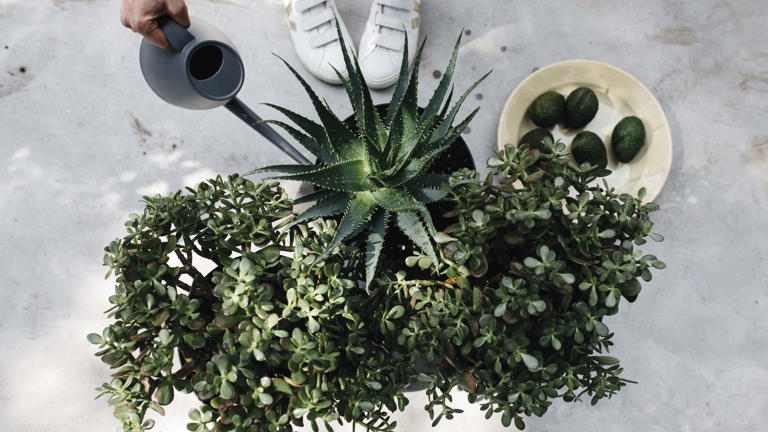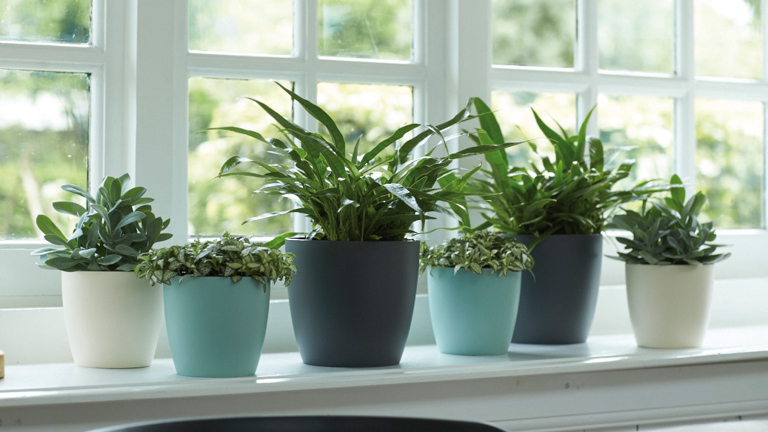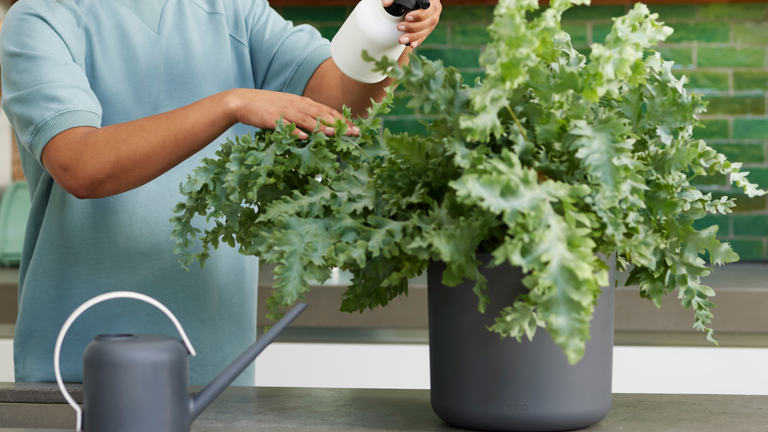
Happy and healthy houseplants in Summer
Watering plants
Now your plants receive a lot of light and warmth, they will grow a lot. This means they will need more hydration and you will notice that the soil dries out faster. Fortunately, you can solve this easily by watering your plants more often. But be careful with giving too much water because then root rot is lurking. But how do you know what is the best amount of water to give? That is indeed not always easy, but your fingers are the best tool for this!
Regularly stick your finger about 5 cm into the soil to feel whether it is dry or moist. Some plants like to dry out between watering, others prefer to stay moist all the time. As a basis, you can assume that plants with thick leaves such as the Crassula (Jade plant), Kalanchoe and the Hoya prefer a drier soil and plants with thin leaves such as the Begonia, Calathea and the Fittonia prefer a little more moisture.

Watch out for bright sun
Just like us, plants can be burnt by the sun. Some plant species burn faster than others. In general, plants with thick leaves can tolerate more sun than those with thin leaves. A burned leaf is permanently damaged, it will never recover. That is why it’s important to protect them from the bright sun. There are several ways to do this:
- Think carefully about where you place each plant. Especially in front of a south-facing window, leaves often have to endure a lot from the sun. In the summer it’s best to only place plants with thick leaves directly in the sun, such as a succulent plant or a cactus.
- Do you notice that the sun has become too bright in the summer? Then place your plants a little further away from the window. The sun's rays are less intense there.
- A net curtain can serve as a filter against the bright sun. The advantage of this is that you only have to close it when the sun gets too bright.
- You can also put special foil on your windows. This is actually intended to prevent a view from outside, but it also works well as a sun filter for your plants.
- In nature, plants often grow in the shade of trees. You can mimic this by placing or hanging a plant that can withstand the sun in front of your more vulnerable plants so that the sturdier plant receives the most direct sunlight.

Rain shower
Due to the heat, plants can occasionally go a bit limp. Sufficient watering helps, but they also recover from a fresh rain shower. When it’s warm, a plant evaporates a lot of water through the leaves, a kind of sweating. In nature they occasionally get a rain shower and after such a shower the leaves immediately look fresh again. It may be a hassle, especially if you have a large collection, but they really like putting your plants outside when it rains! Spraying with a plant sprayer or putting your plants under the shower is of course also possible, but nothing can beat fresh summer rain. Besides the fact that it has a refreshing effect, the leaves are also rinsed clean by spraying or the rain. A clean leaf ensures a better absorption of light so that your plant grows better than ever.
Maybe a fun fact: It is often said that plants can burn when you spray them in full sun because the water droplets act like a magnifying glass. But it seems that this is a myth. Research shows that the magnifying glass effect is not strong enough to cause burns. To be honest, I'd rather err on the side of caution for now and not spray my plants when they're in full sun.
Put them outside
Houseplants can be kept outside in the summer. For example, my large cactus moves to the garden every spring. In theory, every houseplant can go outside in the summer, but again, not every species can tolerate direct sunlight as much. It is always important to let them get used to the (sun) light, because outside light is much more intense than the light inside.
An additional advantage is that when you suffer from a pest in your plant, these annoying critters often develop less quickly outside. As soon as it is warm enough, the plants are immediately moved to a sheltered spot in the garden if I discover any mealybugs.
Nutrition
Now that your plants are growing so well, they could use a little extra nutrition. Rapid growth also means that more nutrients are needed, such as certain minerals that a plant extracts from the soil in nature. These minerals ensure, among other things, the production of flowers, beautiful green leaves and healthy roots. I myself always use liquid food for houseplants and stick to the dosage stated on the packaging.
Look at your plant
My last and best tip, which actually applies to every season, is to take a good look at your plant and regularly stick your finger in the soil. For example, do you see that the leaf is a bit limp? Then feel the earth. When it is dry, you can water. If the soil is still damp or even wet, you may have watered too much or the spot may be too warm for your houseplant. Do you see damaged spots on the leaf? That could be combustion. Make sure your plant gets less direct sunlight. It will take some time, but eventually you will see what your plant needs.

With this blog I hope to have given you some tools to keep your plants healthy and happy during this wonderful season. For now lots of fun growing in your own urban jungle!
Who is Urbanjungling?
